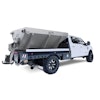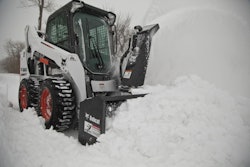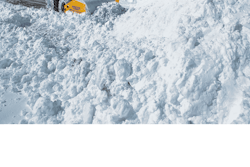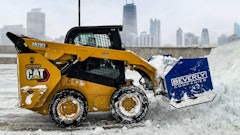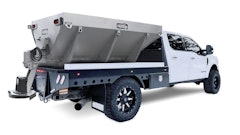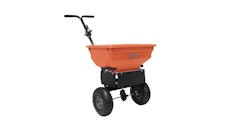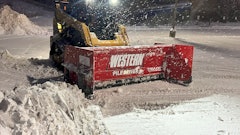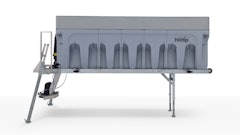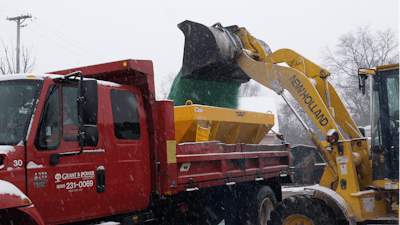
Last year was a very complicated year in terms of salt supply.
Mark Arthofer, CSP, of Dubuque, IA-based Skyline Construction recently shared his views on this year’s salt supply outlook and other trends during the SIMA Summer Pop-Up event in June.
Having been in the snow business for a little over 20 years and brokering salt for at least 15 years, he is aware of some of the trends and how things are going and changing.
“When I first started 20 years ago you didn't have to worry about getting salt,” Arthofer said. “You just went to the pile and you were able to get it. There was never talk of shortage.”
It was more within the past decade that the issue of salt shortages has become more of an issue.
“It brings a whole new dimension to how you prepare your salt and what you should be looking at as a contractor,” he said. “It's time to be thinking about next winter. Let's start thinking snow and tell COVID to go away, we're done.”
Salt Shortage No More
“If there was ever a year that everybody was questioning whether or not they're going to get salt, it was last year,” Arthofer said.
Salt supplies were depleted across the Midwest and even the East Coast area due to the widespread winter the year before. It became more of a challenge in the aftermath of the snow which led to extensive spring flooding that created challenges for barge traffic on the Mississippi River.
Arthofer said ultimately the barges are the key to the Midwest salt supply coming up the Mississippi River.
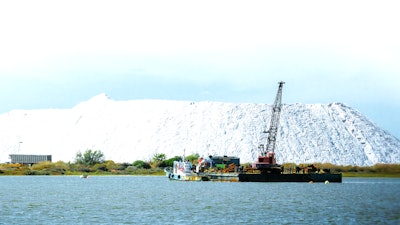
Also, flooding was minimal this spring and barge traffic was able to get on the river early.
He says due to those factors, the prices are coming down in 2020. “It is not a tremendous amount, but substantial in comparison to last year because last year was a demand market.”
However, Arthofer pointed out that it doesn’t take much for things to change. “We get a lot of heavy rains and the river goes to flood stage,” he said. “They haven't made any more rivers, but they're making more roads and parking lots and the drainage. Whenever we get a big rain everything's going towards the river, so it's changed the dynamics of transportation.”
Arthofer said contractors often don’t think about that aspect of sale procurement.
“When it comes to salt supply 75% of the cost of salt is logistics,” he says. “It's not the salt. It's where you are located, how can they get it to the easiest and where can you store it? The more times you have to handle it, the more cost there is.”
COVID Conundrum
Early in the pandemic, there were concerns when President Trump talked of closing the ports, which could have eliminated ships coming in. Ultimately, road salt was included under essential business for public safety purposes which alleviated many of the issues. However, there remains the chance of outbreaks of COVID-19 in the salt mines, which could have some impact on the salt supply chain.
“Everybody is trying to put things in place, planning for things that they’ve never planned for before,” he said.
For example, for snow contractors trying to plan around COVID-19, say a blizzard hits but your business has been impacted by an outbreak of coronavirus. What are you going to do? Who are the back-ups?
“We've never had to think that way before,” Arthofer said. “Maybe for some of us it's a wake-up call that we should have plans in place but I'm not liking being forced into making those plans.”
From a salt perspective, he notes that early on it appeared there could be an impact. There has not been, and it now appears the supply is going to be fine.
While the salt supply appears fine, COVID-19 has led to some snow removal customers in holding off on signing their contracts.
“That's a challenge because you know, depending on how large those accounts are it's like how big of a risk do you take,” Arthofer said. “If you've got a very large complex and they're holding off signing, what if they need 500 tons of salt. Do you gamble on the fact of purchasing that and having it, or, or taking the chance of not being able to get it?”
Without making a direct recommendation, he notes that for this year, the supply is there.
“If there's ever a year that I that I would say you could take that gamble this would be that year,” Arthofer said. “I wouldn't wait till December January, because what if all of a sudden, it gets to be a gangbuster winter.”
Undoubtedly, people are nervous across the country because nobody knows what’s going to happen if there is another substantial outbreak this fall.
Many companies are talking about furloughs and if that’s the case, their parking lots may not need to be cleaned all winter long.
“It's going to create some challenges for us as an industry, there's no doubt about it,” Arthofer said.
Procurement
Arthofer said there are more small salt brokerage companies starting to pop up. Also, he says there are more companies bringing salt in.
From a domestic perspective, the salt is coming out of the ground and only so much can be mined in a day.
“When you get mild years like this one, they can get restocked, but then you have to think too that the piles can only hold so much,” he said. “With the demand getting bigger, the storage areas are not getting bigger.”
Many municipalities or states are starting to take summer fill and get everything maxed out to ensure having salt for the winter.
When you when you look at the major players in the salt business, the contractor market is a secondary market.
“Given the fact that that's the case, salt supply is going to get short quick if we have a bad winter because they're going to take care of the municipal contracts first,” Arthofer said. “That could be a challenge. If you're a contractor and you're serious about snow, you need to really look at your salt procurement procedures and look at what you can store. If you don't have storage, it might be one of the things you want to start looking at because if it's important for your business, then you might want to think that way.”
By diversifying and obtaining salt from multiple sources, he says Skyline has never run out of salt.
“I'm not going to say the prices have stayed the same,” Arthofer noted. “Again, it gets to be back to a logistics thing. I may have had to bring it a long way to get it, but I've never had anybody run out of salt.”
As a broker, he tries to personally not be a salesman.
“I want to try to help people learn and if I can learn from them, I mean that's what it's all about,” Arthofer said. “It's about really creating a partnership.”
He noted that for himself, he has observed and learned from times in different municipal shops and garages.
“I've been able to take some of that technology bring it into our own business, which is just helped us out tremendously,” he says. “As I'm out brokering, I'm doing the same thing I'm trying to educate people, my salt customers what I've seen and what I'm doing different as a result.”
When procuring salt, it’s important to note whether the person that’s selling you the salt is really only selling you salt or are they someone who really wants to cultivate a business relationship and have your best interest in mind.
“Whoever you’re dealing with, you kind of need to know their background also,” Arthofer said. He suggests asking about their supply chain, their storage capacity and history in meeting customer demand.
Also, to help counter any concerns from a salt supply perspective in relation to cost, he recommends adding a clause for your end customer in any contract related to salt supply and price.
For example, his price on salt is contingent on supply and price of the Dubuque terminal.
“If you're able to get it in somewhere else and not spend a lot more money at least you're covered but all of a sudden, you know, you go from $70 on salt to $140 on salt, you got to make that up someplace,” he said.
Commitments for salt are being brokered earlier than they would have five or 10 years ago as well.
The companies that are supplying municipalities, their goal is to supply the municipalities, figure out what they have left for pad space and then take that and sell to the contractors.
“If you want the sure thing, try to find a provider that's going to be able to get your salt earlier,” Arthofer said. Typically, on those earlier shipments, the prices will be better.
Closer into the fall, more materials are moving on the river so there is competitive for space. As with most products, salt prices are driven by the market. Arthofer notes that if you want the best pricing, more contractors are committing to sale totals early.
“At least your bigger players are the ones that are definitely looking ahead to make sure that they are getting their salt supply,” he said.
Foreign vs Domestic
There are so many different types of salt all over the world. Procurement of either domestic or foreign salt has its own risks and opportunities.
Arthofer said he has started to bring in foreign salt to handle more supply.
“I've learned some lessons,” he said. “There's a huge difference in qualities of salt. You want to ask for analysis, and you want to know what the moisture content is and guaranteed moisture content.”
Everybody just thinks salt is salt. In snow removal, that is simply not true.
Based on his own experience, Arthofer suggests asking for analysis and inquiring about where it’s coming from what the analysis on it, the grade, and the moisture content.
“If it's a really fine grade you end up using salt way faster than you would if you have the rock salt but you don't want too much rock salt in there either because now you know you're just spreading gravel,” Arthofer said.
Treated Salt
As an industry, snow and ice contractors are generally trying to use less salt.
“If you really look at the global picture of it, how are we going to use less salt when there's more pavement every year? If we're just using salt, we're never going to use less so we must look at alternatives and treated salt, I do believe is going to get to be very up and coming trend.”
More states are looking into treated salt with some legislation coming down related to chlorides in water bodies. and you're starting to see more and more states that are looking at doing it.
“Because of that, you know, what's your alternative, the only way you're going to use less salt is if you if you put some kind of an additive with it, to try to make that happen,” Arthofer says. “I think the demand is there.” He notes that when he first started with treated salt eight years ago, he is now about 50 percent white salt and 50 percent treated.
“People are seeing the difference,” Arthofer says, adding that the 2019-20 winter wasn’t much of a season to really push people toward the treated salt option.
“The winter before was so cold and nasty out so they definitely saw the benefits of treated salt,” he says.
Among the benefits of having a mix, Arthofer points out that white salt can be utilized when it’s a bit warmer and the treated salt when its cooler, in conjunction with a liquid application program.
“Hands down using liquids with that it's going to minimize salt usage,” he says. “I sell salt, but I know I'm still going to stay selling salt no matter what.”



